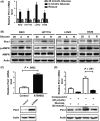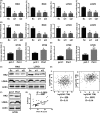Pim1 supports human colorectal cancer growth during glucose deprivation by enhancing the Warburg effect
- PMID: 29516572
- PMCID: PMC5980151
- DOI: 10.1111/cas.13562
Pim1 supports human colorectal cancer growth during glucose deprivation by enhancing the Warburg effect
Abstract
Cancer cells metabolize glucose mainly by glycolysis and are well adapted to metabolic stress. Pim1 is an oncogene that promotes colorectal cancer (CRC) growth and metastasis, and its expression is positively correlated with CRC progression. However, the mechanism underlying Pim1 overexpression during CRC progression and the role of Pim1 in CRC metabolism remains unclear. In the present study, we discovered that Pim1 expression was significantly upregulated in response to glucose deprivation-induced metabolic stress by AMP-activated protein kinase signaling. Pim1 promoted CRC cell proliferation in vitro and tumorigenicity in vivo. Clinical observations showed that Pim1 expression was higher in CRC tissues than in adjacent normal tissues. Pim1 overexpression in CRC tissues not only predicted CRC prognosis in patients but also showed a positive relationship with 18 F-fluorodeoxyglucose uptake. Further in vitro experiments showed that Pim1 promoted the Warburg effect and that Pim1 expression was positively correlated with hexokinase 2 and lactate dehydrogenase A expression. Pim1-silenced cells were more vulnerable to glucose starvation, and Pim1-induced tumor proliferation or tolerance to glucose starvation was attenuated by blocking the Warburg effect. In conclusion, glucose deprivation is one of the mechanisms that leads to elevated Pim1 expression in CRC, and Pim1 upregulation ensures CRC growth in response to glucose deprivation by facilitating the Warburg effect in a compensatory way.
Keywords: AMPK; Pim1; Warburg effect; colorectal cancer; glucose deprivation.
© 2018 The Authors. Cancer Science published by John Wiley & Sons Australia, Ltd on behalf of Japanese Cancer Association.
Figures







References
-
- Hirayama A, Kami K, Sugimoto M, et al. Quantitative metabolome profiling of colon and stomach cancer microenvironment by capillary electrophoresis time‐of‐flight mass spectrometry. Cancer Res. 2009;69:4918‐4925. - PubMed
-
- Lin L, Huang H, Liao W, et al. MACC1 supports human gastric cancer growth under metabolic stress by enhancing the Warburg effect. Oncogene. 2015;34:2700‐2710. - PubMed
MeSH terms
Substances
LinkOut - more resources
Full Text Sources
Other Literature Sources
Medical

